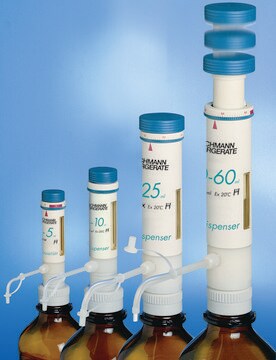Yes, the glass and the cover slip provided are re-usable.
Z359629
Bright-Line™ Hemacytometer
supplied with two cover slips
Synonym(s):
hemacytometers
About This Item
Recommended Products
material
colorless
glass
sterility
non-sterile
wells
2
General description
The ruled surface is 0.1mm below the cover glass, limiting the volume of blood or fluid over a square mm at 0.1cu.mm and over each of 400 squares (within the central square mm) to 0.00025 cu. mm. Contact of the flat, polished cover glass surfaces with cover glass supports produces an exact volume of fluid over the counting area. The difference in surface tension characteristics between the metallic surface on the chamber and the polished cover glass assures smooth capillarity for precise loading and more even cell distribution.
Replacement cover slips sold separately: Z375357
Application
Legal Information
recommended
Choose from one of the most recent versions:
Certificates of Analysis (COA)
It looks like we've run into a problem, but you can still download Certificates of Analysis from our Documents section.
If you need assistance, please contact Customer Support.
Already Own This Product?
Find documentation for the products that you have recently purchased in the Document Library.
Customers Also Viewed
Articles
Cell based assays for cell proliferation (BrdU, MTT, WST1), cell viability and cytotoxicity experiments for applications in cancer, neuroscience and stem cell research.
Cell based assays for cell proliferation (BrdU, MTT, WST1), cell viability and cytotoxicity experiments for applications in cancer, neuroscience and stem cell research.
Cell based assays for cell proliferation (BrdU, MTT, WST1), cell viability and cytotoxicity experiments for applications in cancer, neuroscience and stem cell research.
Cell based assays for cell proliferation (BrdU, MTT, WST1), cell viability and cytotoxicity experiments for applications in cancer, neuroscience and stem cell research.
Protocols
Cell culture protocol for high cell viability freezing using cryopreservation reagents like DMSO. Free handbook download.
Cell culture protocol for high cell viability freezing using cryopreservation reagents like DMSO. Free handbook download.
Cell culture protocol for high cell viability freezing using cryopreservation reagents like DMSO. Free handbook download.
Cell culture protocol for high cell viability freezing using cryopreservation reagents like DMSO. Free handbook download.
-
Can the Z359629 Bright-Line™ Hemacytometer can be reused? Whether cover slip provided with the hemocytometer is reusable?
1 answer-
Helpful?
-
-
Can the Z359629 Bright-Line™ Hemacytometer be used with a Phase Contrast Microscope?
1 answer-
Yes, the Z359629 Bright-Line™ Hemacytometer can be used with a Phase Contrast Microscope.
Helpful?
-
-
Is this hemacytometer for use with phase microscopes?
1 answer-
This product is not listed as suitable for phase microscopy and is not recommended. Please see the link below to review product HS3200, which is manufactured for use with phase microscopes:
https://www.sigmaaldrich.com/product/hausserscientific/hs3200Helpful?
-
-
How many coverslips they give along with the haemocytometer.
1 answer-
As listed on the Product Detail Page, this product is supplied with two cover slips.
Helpful?
-
-
What is the ruling pattern used for Product Z359629, Bright-Line Hemacytometer?
1 answer-
The details for Product Z359629, Bright-Line Hemacytometer are below: Cell Depth: 0.100mm +/- 2% (1/10mm)Volume: 0.1 MicroliterRuling Pattern: Improved Neubauer, 1/400 Square mmRulings cover 9 square millimeters. Boundary lines of the Neubauer ruling are the center lines of the groups of three. (These are indicated in the illustration below.) The central square millimeter is ruled into 25 groups of 16 small squares, each group separated by triple lines, the middle one of which is the boundary. The ruled surface is 0.10mm below the cover glass, so that the volume over each of the 16 small squares is .00025 cubic mm.
Helpful?
-
-
What is the Department of Transportation shipping information for this product?
1 answer-
Transportation information can be found in Section 14 of the product's (M)SDS.To access the shipping information for this material, use the link on the product detail page for the product.
Helpful?
-
Active Filters
Our team of scientists has experience in all areas of research including Life Science, Material Science, Chemical Synthesis, Chromatography, Analytical and many others.
Contact Technical Service











